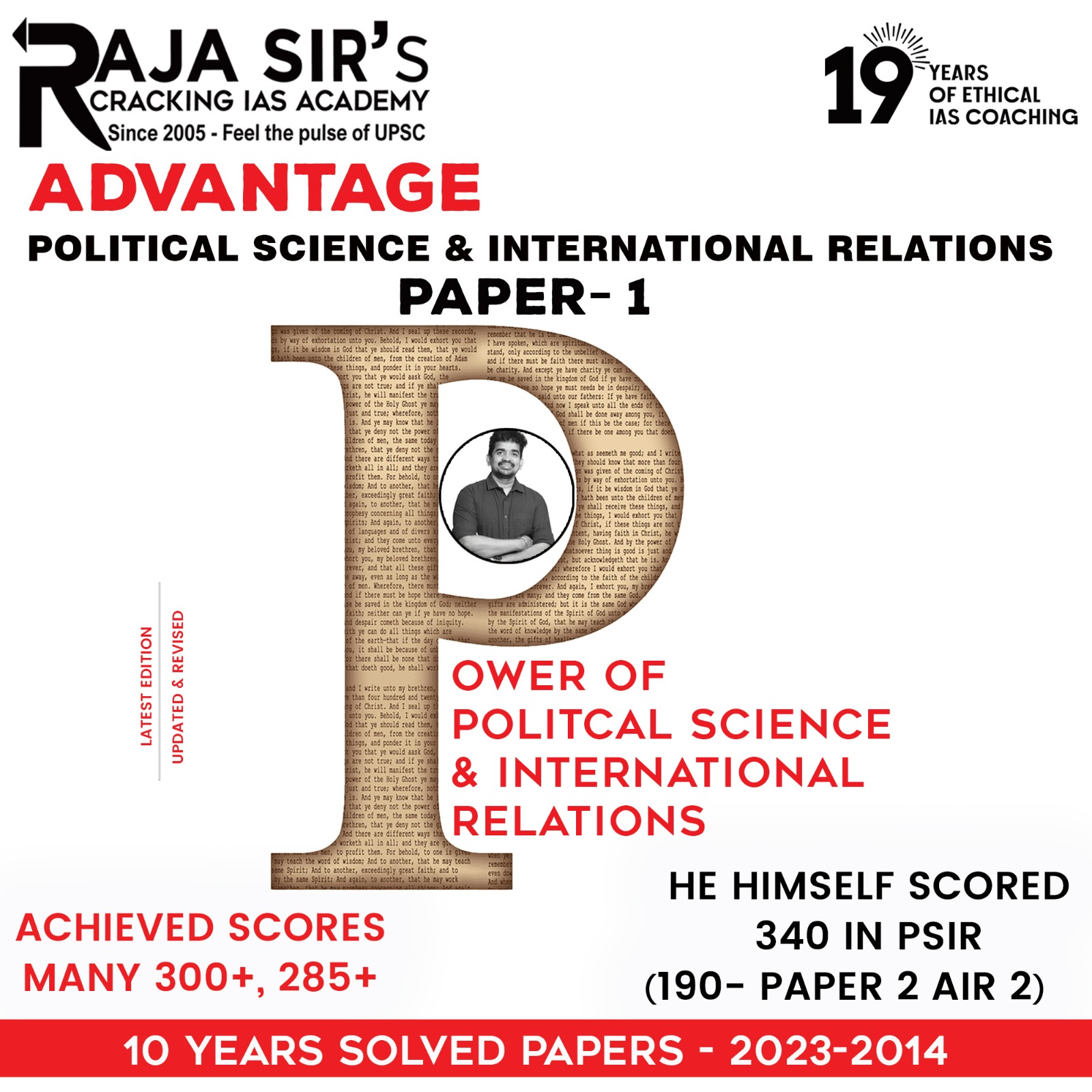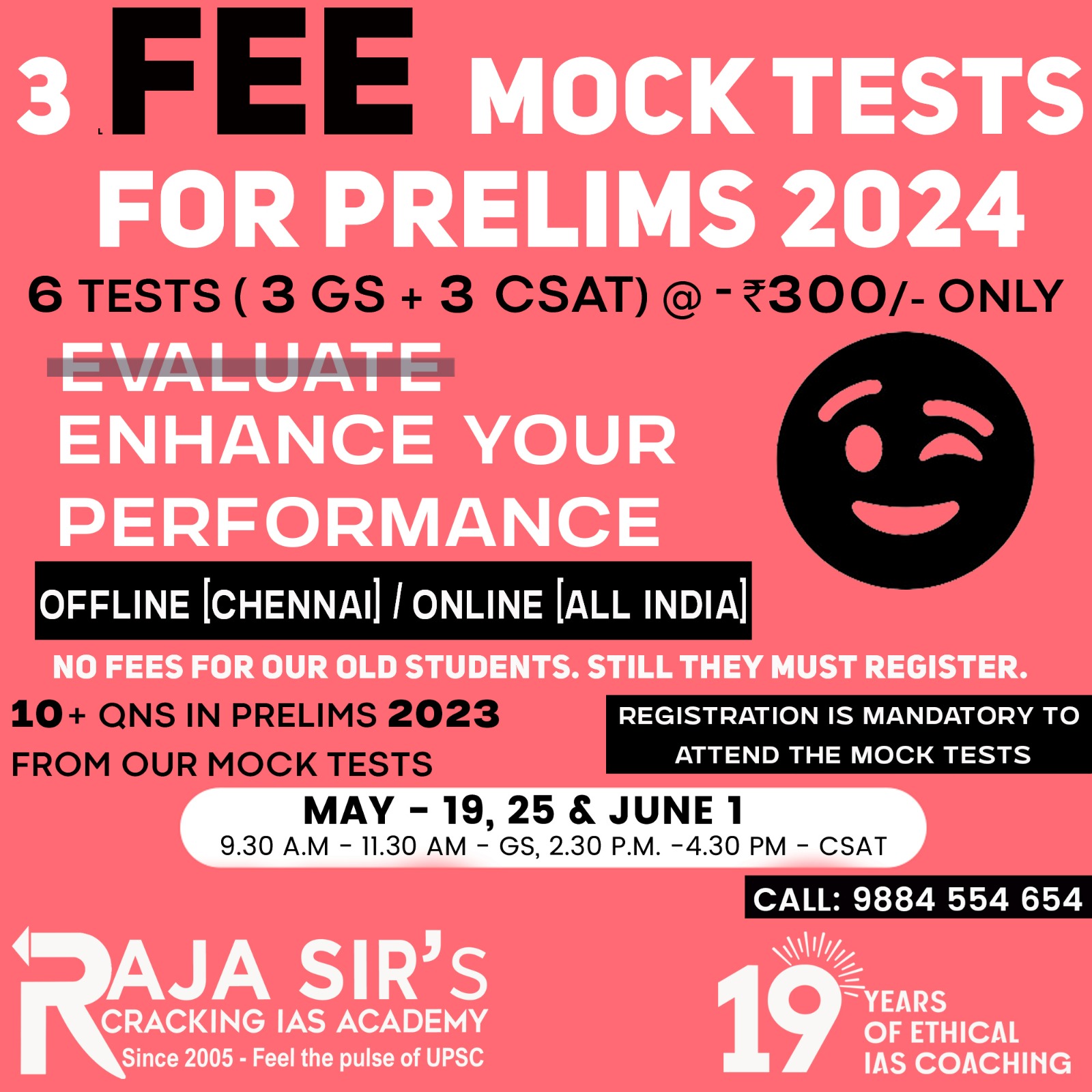- Home
- Prelims
- Mains
- Current Affairs
- Study Materials
- Test Series
 EDITORIALS & ARTICLES
EDITORIALS & ARTICLES
Hit List Questions 10 - PPP 100 PRELIMS 2024 - 28
|
1. |
Which of the following statements is not correct about High Seas Treaty?. (a) It will be implemented under the UNCLOS. (b) It will complement the aim of UNCLOS similar to the working of the Paris Agreement under the UN Framework Convention on Climate Change. (c) Richer nations have pledged money for the delivery of the treaty. (d) China backs the treaty to have a say on its stake in South China Sea.
|
|
2. |
1. It is an aromatic rice cultivated in the Northeastern region of India. 2. It has a more balanced ratio of omega-6 to omega-3 in comparison to the widely consumed non-scented variety. Which of the statements given above is/are correct w.r.t. Joha Rice? (a) 1 only (b) 2 only (c) Both 1 and 2 (d) Neither 1 nor 2
|
|
3. |
Consider the following statements regarding Noctiluca scintillans. 1. It produces Blue Tide. 2. It displaces diatoms. 3. It is unicellular. Select the correct answer using the code below- (a) 1, 2 and 3 (b) 2 only (c) 3 only (d) 1 and 3 only
|
|
4. |
With reference to International Organization for Migration (IOM), consider the following statements: 1. India is not its member. 2. It is an INGO. 3. Its member States endorsed the Migration Governance Framework, for an effective approach to migration governance. How many statements given above is/are correct? (a) Only One (b) Only Two (c) All the three (d) None of the statements
|
|
5. |
ALPS Treated Water in news refer to the context of (a) Low Thermal Desalinated water (b) Ozonated water by traditional method (c) Fukushima N-wastewater (d) Martian water vapour
|
|
6. |
With reference to the Direct seeding of rice (DSR), consider the following statements: 1. It does not involve the spraying of herbicides. 2. Land levelling is not compulsory. 3. It will reduce methane emissions. How many statements given above is/are correct? (a) Only one statement (b) Only two statements (c) All three statements (d) None of the statements
|
|
7. |
Consider the followings statements w.r.t. impact of Black Carbon. 1. upsets the monsoon 2. quickens glacier melt 3. depletes the ozone layer Which of the statements given above is/are correct? (a) 1 and 2 only (b) 2 only (c) 3 only (d) 1, 2 and 3 only
|
|
8. |
Resilience and Sustainability Trust (RST) is established by (a) WB (b) WTO (c) WEF (d) IMF
|
|
9. |
Where is Iroquois Reef?. (a) Philippines (b) Indonesia (c) India (d) USA
|
|
10. |
Consider the following statements with reference to the Sedition: 1. It is dealt with in Section 124A of Criminal Procedure Code. 2. The 22nd Law Commission recommended the total repeal of the Sedition law. Which of the given statements are correct?. (a) 1 Only (b) 2 Only (c) Both 1 and 2 (d) Neither 1 nor 2
|
|
11. |
Gases that absorb infrared radiation include all of the following except (a) carbon dioxide (b) methane (c) tropospheric ozone (d) sulfur oxide
|
|
12. |
Which of the following statements is/are correct about The Sexual Harassment of Women at Workplace (Prevention, Prohibition and Redressal) Act?. 1. Every employer and organisation, whether in the public or private sector, employing 10 or more people must set up an internal committee for receiving complaints of sexual harassment. 2. It places a constitutional obligation on employers to prevent and prohibit sexual harassment in the workplace. (a) 1 only (b) 2 only (c) Both 1 and 2 (d) Neither 1 nor 2
|
|
13. |
With reference to Nilgiri tahr, consider the following statements: 1. It is the state animal of Tamil Nadu. 2. It has been listed endangered by the IUCN. 3. It is most active during evenings. Which of the statements given above are correct? (a) 1 and 2 only (b) 2 and 3 only (c) 1 and 3 only (d) 1, 2 and 3
|
|
14. |
1. Its usage resulted in female eagles laying extremely thick shelled eggs. 2. It is the prime cause behind the decline in bald eagle populations in USA. Which of the statements given above is/are correct w.r.t. Dichloro-Diphenyl-Trichloroethane? (a) 1 only (b) 2 only (c) Both 1 and 2 (d) Neither 1 nor 2
|
|
15. |
The group of air pollutants that tend to cool the atmosphere are known as (a) anti-greenhouse gases (b) ozone enhancers (c) foggy inceptisols (d) atmospheric aerosols
|
|
16. |
Consider the following statements regarding Ordinance making power of the President in India: 1. The President can only promulgate an Ordinance when either of the two Houses of Parliament is not in session. 2. The President cannot promulgate an Ordinance unless he is satisfied that there are circumstances that require taking ‘immediate action’. 3. Ordinances must be approved by Parliament within six weeks of reassembling or they shall cease to operate. How many of the statements given above is/are correct? (a) Only One (b) Only Two (c) All the three (d) None of the statements
|
|
17. |
Clausius Clapeyron relationship refer to (a) increase in the amount of moisture that air can hold (b) decrease in the amount of GHG from automobiles (c) Fukushima N-wastewater controversy (d) release of energy by hydrogen fuel cell
|
|
18. |
Which of the following are the reasons behind Punjab’s decreasing area under cotton cultivation? 1. Whitefly infestation 2. Leaf curl virus disease 3. Pink Bollworm insect disease Select the correct answer using the code given below: (a) 1 and 2 only (b) 1 and 3 only (c) 2 and 3 only (d) 1, 2 and 3
|
|
19. |
1. Wildfires reverse the recovery of Earth''s ozone layer. 2. When chlorofluorocarbons break down, they release chlorine, which eats away at the ozone. Which of the statements given above is/are correct? (a) 1 only (b) 2 only (c) Both 1 and 2 (d) Neither 1 nor 2
|
|
20. |
Consider the following statements related to Production Linked Incentive (PLI) Scheme: 1. It favours the dogma of import substitution. 2. Only Domestic companies can receive financial rewards for manufacturing in India, based on a percentage of their revenue over up to five years. 3. WTO rules prevent India from tying PLI subsidies to domestic value addition. How many of the statements given above is/are correct? (a) Only One (b) Only Two (c) All the three (d) None of the statements
|
|
21. |
Our climate target is (a) 1.5°F (b) 3.6°F (c) 5.1°F (d) 2.7°F
|
|
22. |
The meaning behind “The Ushnisha” is (a) a mark on the Buddha’s forehead, between the eyebrows. (b) the 3-D oval on top of the Mahavira''s head and indicates the wisdom of the Mahavira. (c) the 3-D oval on top of the Buddha''s head and indicates the wisdom of the Buddha. (d) a mark on the Mahavira’s forehead, between the eyebrows.
|
|
23. |
The correct statements are 1. Ozone amounts tend to decrease as we go higher in the atmosphere. 2. Ozone layer exists in the lower part of the stratosphere. 3. Stratospheric ozone is known as bad ozone. (a) 1 and 3 only (b) 1 and 2 only (c) 2 and 3 only (d) 1, 2, 3 |
|
24. |
With reference to the infrastructure facilities developed during colonial rule in India, consider the following: 1. Introduction of Electric Telegraph System 2. Inception of Railway system 3. Opening of Ganges Canal What is the correct chronology of these? (a) 1- 2 -3 (b) 2 -1 -3 (c) 1- 3 -2 (d) 2 - 3 -1
|
|
25. |
Manis mysteria refer to (a) Pangolin (b) Tree (c) Goat (d) Butterfly
|
KEYS & EXPLANATIONS
|
1. |
D |
||||||||||||||||||||||
|
2. |
C |
||||||||||||||||||||||
|
3. |
‘Blue Tide’ appears when luminescent marine life makes the sea appear a deep shade of blue. It occurs when phytoplankton (microscopic marine plants), commonly known as dinoflagellates, produce light through chemical reactions in proteins. Waves disturb these unicellular microorganisms and make them release blue light. If dinoflagellates reproduce rapidly, they may cause so-called ‘red tides’. During this period all the animals (molluscs, fish, etc.) that feed on dinoflagellates also become toxic due to the accumulation of high amounts of toxins from dinoflagellates. It is dangerous to eat such sea animals because the toxins that are contained in them may have various unpleasant effects: some merely irritate the bowel and cause food poisoning, whereas others, being neurotoxins, may even have an effect on memory. |
A |
|||||||||||||||||||||
|
4. |
India became an IOM Member State on 18 June 2008. https://indianexpress.com/article/world/raging-conflict-sudan-displaces-3-million-people-un-8830538/ |
A |
|||||||||||||||||||||
|
5. |
C |
||||||||||||||||||||||
|
6. |
Direct Seeding of Rice (DSR) § Here, the pre-germinated seeds are directly drilled into the field by a tractor-powered machine. § There is no nursery preparation or transplantation involved in this method. Farmers have to only level their land and give one pre-sowing irrigation. § How is it different from conventional method? § In transplanting paddy, farmers prepare nurseries where the paddy seeds are first sown and raised into young plants. § The nursery seed bed is 5-10% of the area to be transplanted. These seedlings are then uprooted and replanted 25-35 days later in the puddled field. § Advantage of DSR: § Water savings. The first irrigation (apart from the pre-sowing rauni) under DSR is necessary only 21 days after sowing. This is unlike in transplanted paddy, where watering has to be done practically daily to ensure submerged/flooded conditions in the first three weeks. § Less Labour. About three labourers are required to transplant one acre of paddy at almost Rs 2,400 per acre. § The cost of herbicides under DSR will not exceed Rs 2,000 per acre. § Reduce methane emissions due to a shorter flooding period and decreased soil disturbance compared to transplanting rice seedlings. Advantages of DSR over Traditional Agriculture:
Limitations:
|
A |
|||||||||||||||||||||
|
7. |
D |
||||||||||||||||||||||
|
8. |
https://www.orfonline.org/expert-speak/imfs-moderate-response-despite-urgent-climate-needs/ |
D |
|||||||||||||||||||||
|
9. |
A |
||||||||||||||||||||||
|
10. |
D |
||||||||||||||||||||||
|
11. |
Tropospheric ozone (O3) is the third most important anthropogenic greenhouse gas after carbon dioxide (CO2) and methane (CH4). Ozone absorbs infrared radiation (heat) from the Earth''s surface, reducing the amount of radiation that escapes to space. |
D |
|||||||||||||||||||||
|
12. |
It places a legal obligation on employers to prevent and prohibit sexual harassment in the workplace.
|
A |
|||||||||||||||||||||
|
13. |
A |
||||||||||||||||||||||
|
14. |
B |
||||||||||||||||||||||
|
15. |
https://timesofindia.indiatimes.com/what-is-the-anti-greenhouse-effect/articleshow/3176216.cms Dimethyl sulfide (C2H6S) is a small molecule released by phytoplankton in the ocean, which can play a big role in regulating the Earth''s climate. It encourages cloud formation above the sea, and is often called an ''anti-greenhouse gas'', since clouds block radiation from the sun and lower sea surface temperatures. In our solar System, Mars and Venus show the Green House Effect, but Titan, the largest planet of Saturn and Pluto, shows the opposite phenomena which is called Anti-Green House Effect. Greenhouse effect occurs because the atmosphere transparent to solar radiation, but largely opaque to infrared and far infrared emitted by the planet / body. But in anti-greenhouse effect, the atmosphere is opaque to solar but lets out infrared. The effect is that the body is cooler than the actual temperature would have been. In case of Titan, both Green House Effect and Anti Green House Effect have been proved. Due to Green House Effect, the temperature goes up by 21K while, due to Anti-Green House effect, the temperature goes down by 9K. The result is that surface temperature is 12 K warmer than without atmosphere. At Pluto, there is different mechanism. Here, the sunlight causes the Nitrogen ice to sublimate which cools the body. Sulfur dioxide is another anti-greenhouse gas. It has a half life of a few years. It can be dumped into the upper atmosphere above equator. The gas reflects part of solar light and heat. However, if sulfur dioxide remains for long and covers the whole planet, it will also have a greenhouse effect, because it also reflects heat that radiates from the planet. Sulfur dioxide depletes ozone and can cause acid rains. Helium conducts heat much faster then nitrogen or oxygen and has a very low greenhouse effect. Building an atmosphere based on helium as an inert gas could be a solution to terraform a planet heated like Venus. However, helium is a light gas and it escapes into space. Inside the atmosphere, it separates into an upper layer. Living organisms need nitrogen for proteins, but still, an atmosphere that contains 50% helium, 30% nitrogen and 20% oxygen would be acceptable. Helium can be used indirectly for Micro Helium Balloons. |
a |
|||||||||||||||||||||
|
16. |
https://www.thehindu.com/news/national/the-legality-of-the-delhi-ordinance/article67038623.ece |
C |
|||||||||||||||||||||
|
17. |
A |
||||||||||||||||||||||
|
18. |
https://indianexpress.com/article/explained/punjab-area-cotton-decrease-8660696/ |
D |
|||||||||||||||||||||
|
19. |
Thanks to the 1987 Montreal Protocol, which regulates the production and consumption of destructive CFCs, the ozone layer is on the mend. The U.N. estimates recovery is expected by around 2066 over the Antarctic and by 2045 over the Arctic. But with these new findings, researchers are concerned that an increase in wildfires could threaten this progress.
|
C |
|||||||||||||||||||||
|
20. |
1 and 3 are true. In the PLI scheme, Domestic and Foreign companies receive financial rewards for manufacturing in India, based on a percentage of their revenue over up to five years. Targeted Sectors: The 14 sectors are mobile manufacturing, manufacturing of medical devices, automobiles and auto components, pharmaceuticals, drugs, specialty steel, telecom & networking products, electronic products, white goods (ACs and LEDs), food products, textile products, solar PV modules, advanced chemistry cell (ACC) battery, and drones and drone components. https://www.thehindubusinessline.com/opinion/how-good-a-scheme-is-pli/article67038364.ece In 2020, the Government of India launched the Production Linked Incentive (PLI) scheme for promoting domestic manufacturing, import substitution and the Make in India initiative. Initially launched for 3 sectors, later, it was extended to 14 sectors in 2021 due to the success and promotion of local production across categories.
Potential of PLI scheme
Challenges faced by the Production linked Incentive Scheme (PLI):
PLI scheme has seen major success in the Mobile and allied Component Manufacturing sector, with the largest mobile phone production and export between 2021 and 2023. To integrate India into global supply chains and make it a manufacturing hub, certain reforms are also needed, like focusing on supply chain co-location, increasing the efficiency of domestic manufacturing, infrastructure development and pushing for labour-intensive sectors to ensure long-term sustainability. |
B |
|||||||||||||||||||||
|
21. |
D |
||||||||||||||||||||||
|
22. |
The famous Chinese traveller Hiuen Tsang who visited the place around AD 640 referred to it as Anandpur. He has recorded the existence of 10 Buddhist monasteries and said that about 100 monks were staying in them. https://frontline.thehindu.com/the-nation/article9874982.ece |
C |
|||||||||||||||||||||
|
23. |
Ozone that occurs in the troposphere is a much smaller proportion of the total planetary ozone and is regarded as ''bad'' ozone since it reacts easily with other Molecules making it highly toxic to living organisms. Tropospheric ozone is known to have negative impacts on such things as crop production, forest growth and human health. Tropospheric ozone is a key component of photochemical smogs which are observed in many cities. Stratospheric ozone is a naturally-occurring gas that filters the sun''s ultraviolet (UV) radiation. This is typically regarded as ''good'' ozone since it reduces the harmful effects of ultraviolet (UV-B) radiation. A diminished ozone layer allows more radiation to reach the Earth''s surface. Excessive exposure to UV-B at the surface of the earth has been shown to cause harmful effects in plants and animals. Absorption of UV-B by ozone in the stratosphere reduces the amount of UV-B reaching the earth''s surface and also generates heat that plays a role in maintaining the temperature structure of the atmosphere. |
B |
|||||||||||||||||||||
|
24. |
Lord Dalhousie became the governor-general of India in 1849. In 1852 he introduced the Electric Telegraph System in India. The first telegraph line from Calcutta to Agra was opened in 1854, covering a distance of 800 miles.
When the Ganges canal formally opened on 8 April 1854, its main channel was 348 miles (560 km) long, its branches 306 miles (492 km) long and the various tributaries over 3,000 miles (4,800 km) long. After irrigation was commenced in May 1855, over 767,000 acres (3,100 km2) in 5,000 villages were irrigated. On 16 April 1853, the first passenger train ran between Bori Bunder (Bombay) and Thane, a distance of 34 km. https://www.mondaq.com/india/renewables/1331376/redefining-infrastructure-a-pathway-for-future |
A |
|||||||||||||||||||||
|
25. |
A |









 Latest News
Latest News



 General Studies
General Studies